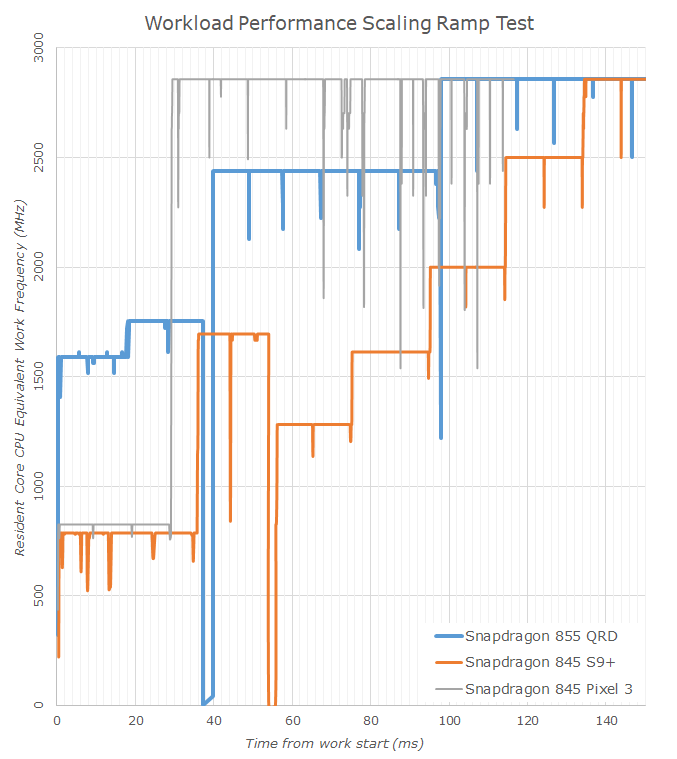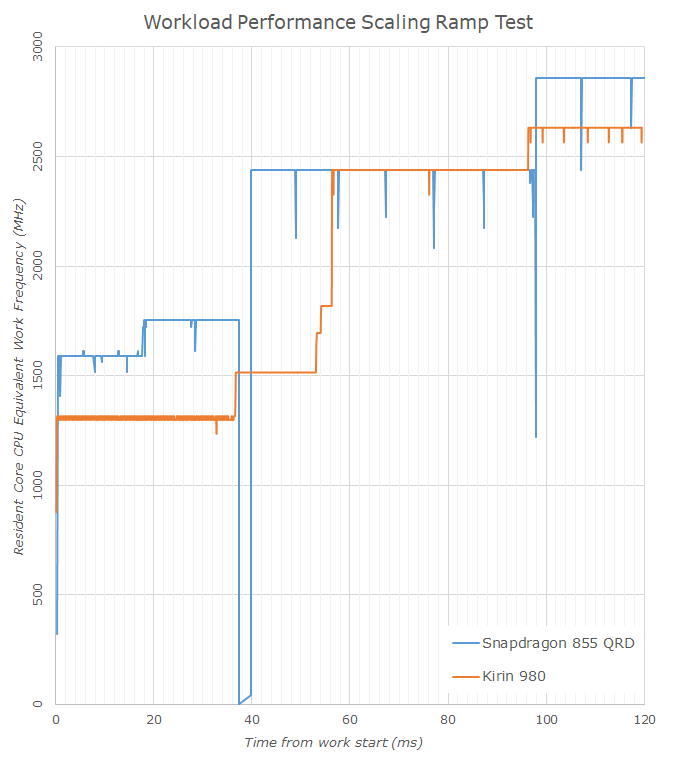The Snapdragon 855 Performance Preview: Setting the Stage for Flagship Android 2019
by Andrei Frumusanu on January 15, 2019 8:00 AM EST- Posted in
- Mobile
- Qualcomm
- Smartphones
- SoCs
- 7nm
- Snapdragon 855
System Performance - Slightly Underwhelming?
While synthetic steady state workloads are one thing, real-world workloads are more transactional and their performance is determined not just by hardware, but as well by software. Here things like the CPU scheduler and OS APIs can have a big effect on the resulting perceived performance of a device.

Starting off with PCMark’s Web Browsing 2.0 test, the Snapdragon 855 goes off to a bad start. Here for some reason the S855 QRD wasn’t able to distinguish itself from the lower end of Snapdragon 845 devices – here we had expected the phone to perform and compete similarly to the Kirin 980 in the Mate 20’s.

The video editing score is again also quite mediocre, but again the reason for this is that this test has largely reached a performance plateau where most of today’s devices no longer really showcase meaningful differences between each other.

The writing sub-test is among one of the most important in PCMark, and luckily here the Snapdragon 855 QRD performed as expected as it’s within range of the Mate 20’s.

The photo editing sub-test is characterised by shorter heavy RenderScript workload bursts. The QRD performs well, although it’s within the results of the top Snapdragon 845 devices.

Finally in the data manipulation result which is more single-thread bound, we see the Snapdragon 855 perform well, but still remains neck-and-neck with the Kirin 980 devices as well as behind the Pixel 3’s very aggressive scheduler implementation.

Overall, the Snapdragon 855 QRD in PCMark ended up among the top scorers, however I found the result to be a bit disappointing as it doesn’t appear to achieve a higher ranking than the Pixel 3, and Huawei’s Kirin 980 Mate 20’s are also ahead.


I’ve discussed the results with Qualcomm, and they were surprised to see the numbers end up like this. They stated that it’s something they will look into, and stated that it’s possible that the scheduler and software stack on commercial devices might improve performance. Something to be revisited once we get our hands on the first phones.
The web-based benchmarks such as Speedometer 2.0 and WebXPRT 3 showcase similar relatively muted results. Here I had expected Qualcomm to perform really well given the scheduler performance showcase of the Snapdragon 845. The results of the Snapdragon 855 are quite meagre, especially in a steady-state throughput workload such as Speedometer 2.0. Here the Snapdragon 855 only manages to showcase a ~17% improvement over the last generation, and also lags behind the Kirin 980 by some notable amount.
Performance Scaling Ramp Test
One of the newer kind of tests I introduced last year and has used in our review of the Apple iPhone XS is the scaling ramp test – here showcasing the improved DVFS responsivity of iOS12 across several generations of iPhones.
I’ve quickly ran this on the S855 QRD to be able to get a sense of the scheduler and DVFS mechanism:
Here we see the Snapdragon 855 QRD being able to scale from a sleeping idle workload state to its maximum performance state in around 100ms. To compare this, I also showcase the scaling behaviour of the S845 in both the S9+ as well as the Pixel 3. The difference between the Pixel 3’s aggressive boost behaviour and the S9’s more step-wise frequency scaling showcases the best visual representation of the perceived responsiveness difference between the two devices.
The Snapdragon 855 here falls somewhere in-between both. It’s to be noted that the workload does get boosted to an “efficient” big core at 2.45GHz in around 40ms which is a very fast scaling behaviour.
Comparing the Snapdragon 855 against the Kirin 980, we see that the Snapdragon isn’t any slower in reaching the maximum performance states. What is odd in these results is that the workload sees a significant pause of ~2.4ms when migrating over from the little cores, something that seems to affect only devices with Qualcomm’s custom scheduler. It’s an interesting find that I’ll have to investigate more.
Overall, real-world performance of the Snapdragon 855 is a bit lower than I had expected it to be. I’m not exactly sure what the cause here is; on the scheduler side we’ve verified that the workload doesn’t inherently scale slower than the Kirin 980. The only other explanation I could see is that we might be seeing some disadvantage of the smaller L3 cache or even the higher DRAM latency.
As we’ve seen in past Snapdragon performance previews, final commercial device performance is subject to change, and it’s possible the performance situation will be more tuned in actual shipping phones.












132 Comments
View All Comments
WildBikerBill - Wednesday, January 16, 2019 - link
What I want to know is...now that we know the high end, what do the affordable mid-range products become?B3an - Wednesday, January 16, 2019 - link
This SoC is VERY disappointing. Wont be upgrading this year to any phone that has this.Hopefully Samsungs new SoC for 2019 is much MUCH better than the utter joke they had in the Galaxy S9... That was a fucking disaster... I'm hoping it actually performs well in REAL WORLD cases this time, not just mostly meaningless benchmarks, but i doubt it. Samsung reminds me of when desktop PC GPU makers would cheat in benchmarks by using driver hacks.
serendip - Wednesday, January 16, 2019 - link
It looks like Qualcomm is having an Intel-like moment where performance stops having meaningful increases year-on-year. For me, an SD835 device is more than fast enough and an 855 only makes sense for higher-performing larger devices like Windows tablets.Time to focus on the software then... my old SD650 device got a new lease on life with a clean build of Lineage on Android Pie. The same slowdown that hit the laptop/PC markets could cause a crash in the smartphone market as people keep their phones for 3-4 years instead of upgrading annually.
serendip - Wednesday, January 16, 2019 - link
I doubt it. Apple seems to be the only one with a cracking chip design team. Huawei seems to be doing decent work with HiSilicon but ARM designs are still far behind.Does it matter though? Apple's latest chips are so overpowered for their phones and tablets, the performance numbers are more for bragging rights than anything else. That could change once they start using A-series chips in their laptops.
yankeeDDL - Sunday, January 20, 2019 - link
Disclaimer: I have been using a Galaxy S8 (SD835) and I don't feel the need to upgrade anytime soon, however:a) Having more power is always nice, and there are times where the phone ... stutters, especially when moving from "heavy" games.
b) The gap with the iphones is embarrassing, and I don't see any technical justification. Yes, the iPhones are optimized all around (HW+SW) thanks to their closed ecosystem, but nearly 2x gap on the GPU is a deliberate choice which should be, at the very least justified.
We need competition in the mobile CPU/GPU, or Qualcomm will quickly become the Intel of mobile, sitting on his a** until something better comes along.
cha0z_ - Monday, January 21, 2019 - link
Dunno why Andrei is so kind in his wording about the new snapdragon. For start it's nothing that more powerful vs the kirin 980 (while it was shaped to literally obliterate it in both CPU/GPU, especially the GPU). Also even the A11 is making a joke of it and the A12 sustained performance is higher than the sd855 peak in GPU... and CPU is also for the A12 and even A11.I would kinda understand for the sd855 to lack behind the A12 with 15% in CPU/GPU, will accept somewhat to lose to the A12 even with more, but losing to the A11 is roflmao funny. How in the world you can call it success when qualcomm(as a leader in that regard) can't catch up with apple for years? Recently even the GPU started to lag behind BIG time, before atleast that was on par. Well.. cool.
mfaisalkemal - Sunday, January 20, 2019 - link
Hi Andrei, what do you think about 3 benchmark on https://www.asteroidsbenchmarks.com ?all of them include metal and vulkan api benchmark so we can comparing iOS and Vulkan mobile.
The benchmark include off screen test.
DontTreadOnMe - Thursday, January 24, 2019 - link
Does this A76 CPU support the pointer authentication codes that Apple have had since iPhone X? It seems like this is a potentially very useful security feature that it would be nice to see on Android devices.Uol - Tuesday, January 29, 2019 - link
thank you <a href="https://www.wikipedia.org/">site</a>Nystiael - Thursday, February 7, 2019 - link
Very nice. I will but it by I don't have the money atm.Greetings
https://showbox-apk.mobi